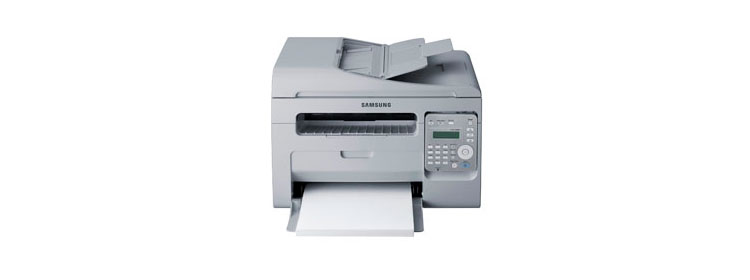The Samsung SCX 3405FW is a bare-bones monochrome laser multifunction printer that’s intended for a small office or department. This sturdy unit combines a high-resolution one-sided color scanner and copier, plus faxing capabilities (hence the “F” in the model number) accessible over a LAN or Wi-Fi (hence the “W”). With the exception of cable connections, all functions are performed from the front, including paper replenishment and toner service. A 700-sheet starter cartridge is included; its normal toner is rated to deliver about 1,500 pages in standard mode. There’s also an Eco mode.
For paper handling, Samsung substitutes a paper cassette for a 150-sheet front-loading paper tray, which no doubt helped rein in its relatively large 15-by-11-inch footprint. The main feeder can hold paper or as many as 10 envelopes. The output tray holds 100 sheets; there is no two-sided option. The 3405 is rated to deliver up to 10,000 pages per month. It draws 310 watts when operational, 30 watts in standby mode and 1.2 watts when sleeping. It weighs just shy of 15 pounds.
The 3405 requires about 20 inches of height clearance to access its flatbed scanner, a TWAIN-compatible color device with a native resolution of 600 x 600 dpi, and maximum resolution of 4,800 x 4,800 dpi with interpolation. Features include a 40-page auto-feeder and scan-to-PC function. Standard interfaces are USB, Ethernet and Wi-Fi; there are no ports for printing from or storing to USB drives or data cards, but Wi-Fi Direct connection support permits mobile devices to print using Apple (NSDQ:AAPL) AirPrint, Google(NSDQ:GOOG) Cloud Print or Samsung’s own Mobile Print forAndroid and iOS devices.
The Samsung SCX 3405FW lived up to its rated output speed of 21 pages per minute, but getting there was not without a few bumps. First, the performance numbers. The unit printed black-only text pages and those with integrated graphics at virtually the same pace. After a period of 31 seconds until the first page came out, the 3405 finished printing 21 pages in a total of 1:29.
Setting up the printer was a bit more difficult than most. The wireless setup utility requires a USB cable; it can’t send settings to the printer wirelessly, nor could it see the printer after it had an IP address. Configuring the printer for Wi-Fi using its control panel wasn’t a much better option. It obtained an IP address on its own, but entering the passcode using the numerical keypad was clumsy. Absent a software disc, testers went to the 3405’s download page, where manuals, software and drivers for Linux, Mac OS X and Windows can be found as separate downloads. For testing, separate downloads were required for the scanner, fax, “wireless” setup (through USB), printer management and the printer’s own driver.
Uncharacteristic of Samsung, which usually produces excellent software, the management component for the 3405 was practically unusable, as was the interface for its two-line LCD control panel. When installing the driver, the installer package quit all running apps without so much as a prompt, an absolute UI no-no in our book
In all, the Samsung SCX 3405FW performed well enough, but took longer and was more involved to set up than service resellers would probably like. But for $199, this entry-level laser MFP performed up to spec and turned out good quality printouts.







